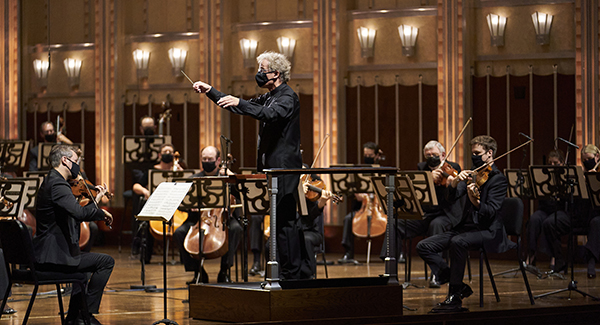by Daniel Hathaway

Pianist Yefim Bronfman, who sat for an informal interview before joining Franz Welser-Möst and the Orchestra for Alfred Schnittke’s Concerto for Piano and String Orchestra, noted that the pandemic gave him the opportunity to learn the 1979 work, which he described as a collage of styles masterfully put together. He said there was loneliness and darkness, but also an element of hope in the music.
It’s a fascinating piece that jerks the listener in multiple directions and sometimes layers different material in a Charles Ivesian manner. Beginning with doorbell-like gestures from the soloist — a descending minor third that inverts itself and changes from minor to major — the mood changes as suddenly as Northeast Ohio weather as the pianist introduces noisome clusters and the strings import a chordal anthem from another tonal world.
A lulling passage leads to a frantic “catch me if you can” chase initiated by the piano, ending with more noble chords from the strings.
A jazzy little interlude finds the pianist’s right hand melody engaging in a conversation with solo double bass before unisons in the piano build to a noisy climax, and a cutoff leaves the piano strings ringing into silence. Repetitive melodic gestures develop into what sounds like a parody of “The Great Gate of Kiev” but with a major-minor disagreement between soloist and orchestra.
What else can happen? More clusters from the pianist. A lower string section elegy. A persistent, repeated-note theme from the piano, then a palindromic return to the material heard at the beginning of the piece. A great rush upwards on the keyboard leaves the soloist playing a simple tune and single high notes to end.
Bronfman’s playing was both efficient and thrilling, and his mood changes chameleon like.

Welser-Möst introduced the Beethoven, noting that he was proud of the chamber music-like playing of The Cleveland Orchestra, and adding that Op. 74 was playful, profoundly philosophical, and full of joy. Even with so many extra hands on the fingerboards, those qualities came through with engaging clarity.
Photos by Roger Mastroianni.
Published on ClevelandClassical.com November 3, 2020
Click here for a printable copy of this article



